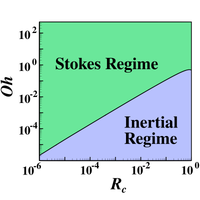当前位置:
X-MOL 学术
›
Phys. Rev. Fluids
›
论文详情
Our official English website, www.x-mol.net, welcomes your feedback! (Note: you will need to create a separate account there.)
Initial regime of drop coalescence
Physical Review Fluids ( IF 2.7 ) Pub Date : 2020-03-13 , DOI: 10.1103/physrevfluids.5.033608 Christopher R. Anthony , Michael T. Harris , Osman A. Basaran
Physical Review Fluids ( IF 2.7 ) Pub Date : 2020-03-13 , DOI: 10.1103/physrevfluids.5.033608 Christopher R. Anthony , Michael T. Harris , Osman A. Basaran

|
When two drops are slowly brought together and first touch, a microscopic liquid neck or a bridge forms between them. The expansion of the neck is controlled by the capillary (Laplace) pressure which diverges when the curvature of the interface is infinite at the point where the drops first touch. The change in topology and the flows that ensue as time advances and the bridge grows from microscopic to macroscopic scales, and the two drops merge into one, are intimately coupled to this singularity in the dynamics. Despite the large volume of work dedicated to this problem, currently experiment, theory, and computation are not in complete agreement with respect to the earliest times following the initial contact of the two drops. Experiments, supported by simulations, report an initial regime where the radius of the connecting bridge grows linearly in time before a transition to either a Stokes regime or an inertial regime where either viscous or inertial force balances capillary (surface tension) force. In the initial linear regime, referred to as the inertially limited viscous (ILV) regime, all three forces are thought to be important. This is in contrast to theory which predicts that all coalescence events begin in the Stokes regime where inertia is negligible. Here we use high-accuracy numerical simulations to show that the ILV regime is only realized when the two coalescing drops are initially separated by a finite distance. Moreover, for two drops that initially just touch at a point, coalescence always begins in the Stokes regime. It is demonstrated that the linear ILV regime is more akin to a Taylor-Culick-type regime whose existence and duration are purely consequences of the use of an initial bridge of finite size that poorly approximates the point contact condition that is a cardinal feature of the coalescence singularity.
中文翻译:

液滴合并的初始方式
当将两滴缓慢放在一起并初次接触时,它们之间会形成微小的液颈或桥。颈部的扩张由毛细血管(拉普拉斯)压力控制,当界面的曲率在液滴首次接触的位置无限大时,该压力就会发散。随着时间的推移,拓扑结构的变化和随之而来的流动以及桥梁从微观尺度到宏观尺度的增长以及两个液滴合并为一个,都与动力学中的这种奇异性紧密相关。尽管为解决这个问题进行了大量工作,但在两个液滴初次接触之后的最早时间,目前的实验,理论和计算尚不完全一致。实验,模拟的支持,报告了一个初始状态,其中连接桥的半径在过渡到斯托克斯状态或惯性状态之前随时间线性增长,在此状态下,粘性或惯性力平衡了毛细管(表面张力)力。在最初的线性状态下,称为惯性有限粘性(ILV)状态,所有这三个力都被认为是重要的。这与理论上的预测相反,该理论预测所有合并事件都始于斯托克斯政权,而惯性可以忽略不计。在这里,我们使用高精度的数值模拟来表明,仅当两个聚结液滴最初以有限距离分开时才实现ILV机制。此外,对于最初仅在某个点接触的两个滴,聚结总是在斯托克斯政权下开始。
更新日期:2020-03-13
中文翻译:

液滴合并的初始方式
当将两滴缓慢放在一起并初次接触时,它们之间会形成微小的液颈或桥。颈部的扩张由毛细血管(拉普拉斯)压力控制,当界面的曲率在液滴首次接触的位置无限大时,该压力就会发散。随着时间的推移,拓扑结构的变化和随之而来的流动以及桥梁从微观尺度到宏观尺度的增长以及两个液滴合并为一个,都与动力学中的这种奇异性紧密相关。尽管为解决这个问题进行了大量工作,但在两个液滴初次接触之后的最早时间,目前的实验,理论和计算尚不完全一致。实验,模拟的支持,报告了一个初始状态,其中连接桥的半径在过渡到斯托克斯状态或惯性状态之前随时间线性增长,在此状态下,粘性或惯性力平衡了毛细管(表面张力)力。在最初的线性状态下,称为惯性有限粘性(ILV)状态,所有这三个力都被认为是重要的。这与理论上的预测相反,该理论预测所有合并事件都始于斯托克斯政权,而惯性可以忽略不计。在这里,我们使用高精度的数值模拟来表明,仅当两个聚结液滴最初以有限距离分开时才实现ILV机制。此外,对于最初仅在某个点接触的两个滴,聚结总是在斯托克斯政权下开始。



























 京公网安备 11010802027423号
京公网安备 11010802027423号